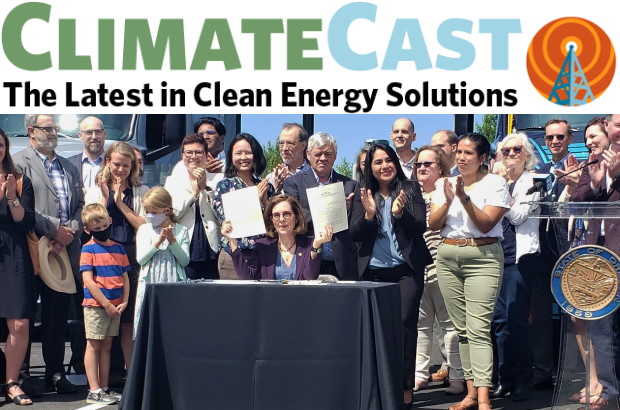Oregon joins the West Coast in leading to 100% clean energy
Earlier this week, Oregon Governor Kate Brown signed a suite of climate and environmental protection bills into law. The centerpiece is House Bill 2021, which establishes a binding timeline for generating all of the state’s electricity (currently the second-largest source of Oregon’s climate pollution) from clean and renewable energy sources by the year 2040. The clean energy transition timeline and interim targets outlined in the bill are among the most ambitious in the nation (matching New York State’s), allowing Oregon to leapfrog from climate laggard to champion. The passage of this bill is a major, unequivocal victory for climate advocates and community organizers alike, with significant incentives and benefits for frontline and other historically marginalized communities, crafted by representatives from and advocates for those communities. Other climate bills signed by the Governor include improved appliance efficiency standards, an extension in funding for the Energy Trust of Oregon and state EV incentive programs, and energy bill protections and weatherization programs for low-income families.
A federal “down payment” on climate
The U.S. Senate this week advanced the latest iteration of a $1 trillion infrastructure deal. This proposal, months in the making, contains the largest ever federal spending on electric vehicle charging stations, public transit and clean water, with an additional focus on infrastructure for “climate resilience.” While the proposal allocates billions to a range of clean energy, pollution reduction, and emissions reductions projects, it also falls far short of the investments climate advocates have identified as necessary—omitting, for example, a Clean Electricity Standard and a Civilian Climate Corps. This places more pressure on Congress to do much more with an anticipated budget reconciliation package. Negotiations continue in the midst of extreme heat waves across the country. With recent calls for the need to invest and support cities' efforts to increase climate infrastructure, the clean energy transition continues to be an opportunity to create and sustain good-paying jobs and increase economic benefits in communities of color.
Whether it’s the Weather or Climate it’s Sure Extreme Heat
The Pacific Northwest made headlines this month for unprecedented triple digit temperatures, but there’s little relief in sight as the region continues to see intense heat and wildfires throughout the West. And it’s not just limited to the typically temperate upper left, but is also affecting folks nationwide. Extreme heat means more than just setting new records, it’s also the most dangerous impact of the climate crisis and a hotter planet, as heat kills more people than any other type of extreme weather. And while “the weather” isn’t “the climate,” it provides an opportunity to focus attention on the climate crisis as well as inequities in how weather extremes affect different communities.
Green Hydrogen: Can it move from Olympic Symbol to Olympic in Scale
While tens of millions tuned into the Olympic opening ceremonies last week, they might not have realized that for the first time hydrogen is powering the iconic Olympic flame. Hydrogen-powered vehicles are also in use transporting some athletes around the games. Beyond the symbolic moment, hydrogen is attracting greater investment as one way to power big vehicles while supporting the transition away from fossil fuels. Hydrogen is produced through electrolysis, so its climate impact and “green” status depends on the energy source powering its production. A growing number of companies around the world are partnering with wind and solar farms to produce more green hydrogen. But the World Energy Council issued a new report noting the high cost of the process, and thus also the need to support new technologies to lower costs and scale up adoption.
One thing you can do: Protect farmworkers from the heat
Summer fruits and veggies abound with flavor and beauty, but this year’s extreme heat also means that it’s extra challenging and dangerous for farmworkers around the country. We can all be grateful for the hard work it takes for many different workers and industries to make food readily available to us in stores and markets, and we can express that gratitude by supporting efforts to protect farmworks with a national heat stress standard.
As the country swelters: Urge your members of Congress to back federal heat bill (seiu.org)




